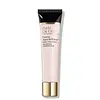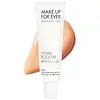What's inside
What's inside
 Key Ingredients
Key Ingredients

 Benefits
Benefits

 Concerns
Concerns

 Ingredients Side-by-side
Ingredients Side-by-side

Water
Skin ConditioningMethyl Trimethicone
Skin ConditioningButylene Glycol
HumectantGlycerin
HumectantGlycereth-26
HumectantPropanediol
SolventDimethicone
EmollientSodium Hyaluronate
HumectantTocopheryl Acetate
AntioxidantSqualane
EmollientHelianthus Annuus Seed Extract
Skin ConditioningPropylene Glycol Dicaprate
EmollientCucumis Sativus Fruit Extract
EmollientSimmondsia Chinensis Seed Oil
EmollientHaberlea Rhodopensis Leaf Extract
Skin ConditioningBeta Vulgaris Root Extract
Skin ConditioningPalmitoyl Tripeptide-1
Skin ConditioningArtemia Extract
Skin ConditioningNymphaea Alba Root Extract
Skin ConditioningHordeum Vulgare Extract
EmollientPolygala Senega Root Extract
RefreshingBeta Vulgaris Extract
Skin ProtectingCaffeine
Skin ConditioningPhenyl Trimethicone
Skin ConditioningAscorbyl Glucoside
AntioxidantBetaine
HumectantTrehalose
HumectantEthylhexyl Palmitate
EmollientCetyl PEG/PPG-10/1 Dimethicone
EmulsifyingLauryl PEG-9 Polydimethylsiloxyethyl Dimethicone
Skin ConditioningCholesterol
EmollientMethyldihydrojasmonate
MaskingMethicone
EmollientCaprylyl Glycol
EmollientTriticum Vulgare Germ Extract
Skin ConditioningYeast Extract
Skin ConditioningTribehenin
EmollientGlucose
HumectantSucrose
HumectantTin Oxide
AbrasiveDimethicone/PEG-10/15 Crosspolymer
Dipropylene Glycol
HumectantPEG-75
HumectantSilica Dimethyl Silylate
EmollientSorbitan Isostearate
EmulsifyingPolysilicone-11
Synthetic Fluorphlogopite
Xanthan Gum
EmulsifyingPolyquaternium-51
Skin ConditioningNylon-12
Citric Acid
BufferingSodium Chloride
MaskingDisodium EDTA
Sodium Citrate
BufferingChlorphenesin
AntimicrobialPotassium Sorbate
PreservativePhenoxyethanol
PreservativeMica
Cosmetic ColorantCI 77891
Cosmetic ColorantCI 77491
Cosmetic ColorantCI 77163
Cosmetic ColorantWater, Methyl Trimethicone, Butylene Glycol, Glycerin, Glycereth-26, Propanediol, Dimethicone, Sodium Hyaluronate, Tocopheryl Acetate, Squalane, Helianthus Annuus Seed Extract, Propylene Glycol Dicaprate, Cucumis Sativus Fruit Extract, Simmondsia Chinensis Seed Oil, Haberlea Rhodopensis Leaf Extract, Beta Vulgaris Root Extract, Palmitoyl Tripeptide-1, Artemia Extract, Nymphaea Alba Root Extract, Hordeum Vulgare Extract, Polygala Senega Root Extract, Beta Vulgaris Extract, Caffeine, Phenyl Trimethicone, Ascorbyl Glucoside, Betaine, Trehalose, Ethylhexyl Palmitate, Cetyl PEG/PPG-10/1 Dimethicone, Lauryl PEG-9 Polydimethylsiloxyethyl Dimethicone, Cholesterol, Methyldihydrojasmonate, Methicone, Caprylyl Glycol, Triticum Vulgare Germ Extract, Yeast Extract, Tribehenin, Glucose, Sucrose, Tin Oxide, Dimethicone/PEG-10/15 Crosspolymer, Dipropylene Glycol, PEG-75, Silica Dimethyl Silylate, Sorbitan Isostearate, Polysilicone-11, Synthetic Fluorphlogopite, Xanthan Gum, Polyquaternium-51, Nylon-12, Citric Acid, Sodium Chloride, Disodium EDTA, Sodium Citrate, Chlorphenesin, Potassium Sorbate, Phenoxyethanol, Mica, CI 77891, CI 77491, CI 77163
Water
Skin ConditioningMethyl Trimethicone
Skin ConditioningPhenyl Trimethicone
Skin ConditioningIsododecane
EmollientAlcohol
AntimicrobialDimethicone
EmollientPEG-9 Polydimethylsiloxyethyl Dimethicone
EmulsifyingButylene Glycol
HumectantGlycerin
HumectantAcrylates/Dimethicone Copolymer
Skin ConditioningVinyl Dimethicone/Methicone Silsesquioxane Crosspolymer
Synthetic Fluorphlogopite
Disteardimonium Hectorite
StabilisingParfum
MaskingCaprylyl Glycol
EmollientPropylene Carbonate
SolventLecithin
EmollientSodium Benzoate
MaskingSodium Chloride
MaskingLepidium Meyenii Root Extract
Skin ConditioningMaltodextrin
AbsorbentSilica
AbrasiveCitric Acid
BufferingSodium Citrate
BufferingTin Oxide
AbrasiveCI 77163
Cosmetic ColorantCI 77891
Cosmetic ColorantCI 77491
Cosmetic ColorantCI 15850
Cosmetic ColorantWater, Methyl Trimethicone, Phenyl Trimethicone, Isododecane, Alcohol, Dimethicone, PEG-9 Polydimethylsiloxyethyl Dimethicone, Butylene Glycol, Glycerin, Acrylates/Dimethicone Copolymer, Vinyl Dimethicone/Methicone Silsesquioxane Crosspolymer, Synthetic Fluorphlogopite, Disteardimonium Hectorite, Parfum, Caprylyl Glycol, Propylene Carbonate, Lecithin, Sodium Benzoate, Sodium Chloride, Lepidium Meyenii Root Extract, Maltodextrin, Silica, Citric Acid, Sodium Citrate, Tin Oxide, CI 77163, CI 77891, CI 77491, CI 15850
 Reviews
Reviews

Ingredients Explained
These ingredients are found in both products.
Ingredients higher up in an ingredient list are typically present in a larger amount.
Butylene Glycol (or BG) is used within cosmetic products for a few different reasons:
Overall, Butylene Glycol is a safe and well-rounded ingredient that works well with other ingredients.
Though this ingredient works well with most skin types, some people with sensitive skin may experience a reaction such as allergic rashes, closed comedones, or itchiness.
Learn more about Butylene GlycolCaprylyl Glycol is a humectant and emollient, meaning it attracts and preserves moisture.
It is a common ingredient in many products, especially those designed to hydrate skin. The primary benefits are retaining moisture, skin softening, and promoting a healthy skin barrier.
Though Caprylyl Glycol is an alcohol derived from fatty acids, it is not the kind that can dry out skin.
This ingredient is also used as a preservative to extend the life of products. It has slight antimicrobial properties.
Learn more about Caprylyl GlycolThis synthetic powder is used to add a pearly/white color in cosmetics.
Ci 77491 is also hydrated iron III oxide. It's sole purpose is to give a red/pink hue to products.
Iron III oxides are classified as inorganic chemicals for coloring.
Synthetically created Ci 77491 is considered safer than those naturally found. This is because the synthetically created version may contain less impurities. Iron oxides are generally non-toxic and non-allergenic.
Learn more about CI 77491Ci 77891 is a white pigment from Titanium dioxide. It is naturally found in minerals such as rutile and ilmenite.
It's main function is to add a white color to cosmetics. It can also be mixed with other colors to create different shades.
Ci 77891 is commonly found in sunscreens due to its ability to block UV rays.
Learn more about CI 77891Citric Acid is an alpha hydroxy acid (AHA) naturally found in citrus fruits like oranges, lemons, and limes.
Like other AHAs, citric acid can exfoliate skin by breaking down the bonds that hold dead skin cells together. This helps reveal smoother and brighter skin underneath.
However, this exfoliating effect only happens at high concentrations (20%) which can be hard to find in cosmetic products.
Due to this, citric acid is usually included in small amounts as a pH adjuster. This helps keep products slightly more acidic and compatible with skin's natural pH.
In skincare formulas, citric acid can:
While it can provide some skin benefits, research shows lactic acid and glycolic acid are generally more effective and less irritating exfoliants.
Most citric acid used in skincare today is made by fermenting sugars (usually from molasses). This synthetic version is identical to the natural citrus form but easier to stabilize and use in formulations.
Read more about some other popular AHA's here:
Learn more about Citric AcidDimethicone is a type of synthetic silicone created from natural materials such as quartz.
What it does:
Dimethicone comes in different viscosities:
Depending on the viscosity, dimethicone has different properties.
Ingredients lists don't always show which type is used, so we recommend reaching out to the brand if you have questions about the viscosity.
This ingredient is unlikely to cause irritation because it does not get absorbed into skin. However, people with silicone allergies should be careful about using this ingredient.
Note: Dimethicone may contribute to pilling. This is because it is not oil or water soluble, so pilling may occur when layered with products. When mixed with heavy oils in a formula, the outcome is also quite greasy.
Learn more about DimethiconeGlycerin is already naturally found in your skin. It helps moisturize and protect your skin.
A study from 2016 found glycerin to be more effective as a humectant than AHAs and hyaluronic acid.
As a humectant, it helps the skin stay hydrated by pulling moisture to your skin. The low molecular weight of glycerin allows it to pull moisture into the deeper layers of your skin.
Hydrated skin improves your skin barrier; Your skin barrier helps protect against irritants and bacteria.
Glycerin has also been found to have antimicrobial and antiviral properties. Due to these properties, glycerin is often used in wound and burn treatments.
In cosmetics, glycerin is usually derived from plants such as soybean or palm. However, it can also be sourced from animals, such as tallow or animal fat.
This ingredient is organic, colorless, odorless, and non-toxic.
Glycerin is the name for this ingredient in American English. British English uses Glycerol/Glycerine.
Learn more about GlycerinMethyl Trimethicone is a type of silicone. It is a solvent and emulsifier.
Solvents are used to keep ingredients together in a product. They can help dissolve ingredients to stable bases or help evenly distribute ingredients throughout the product.
Emulsifiers help stabilize a product. It does this by preventing certain ingredients from separating.
Methyl Trimethicone does not get absorbed into the skin.
Learn more about Methyl TrimethiconePhenyl Trimethicone is a silicon-based polymer. It is derived from silica.
Phenyl Trimethicone is used as an emollient and prevents products from foaming.
As an emollient, it helps trap moisture in the skin. It is considered an occlusive.
Learn more about Phenyl TrimethiconeChances are, you eat sodium chloride every day. Sodium Chloride is also known as table salt.
This ingredient has many purposes in skincare: thickener, emulsifier, and exfoliator.
You'll most likely find this ingredient in cleansers where it is used to create a gel-like texture. As an emulsifier, it also prevents ingredients from separating.
There is much debate on whether this ingredient is comedogenic. The short answer - comedogenic ratings don't tell the whole story. Learn more about comegodenic ratings here.
The concensus about this ingredient causing acne seems to be divided. Research is needed to understand if this ingredient does cause acne.
Scrubs may use salt as the primary exfoliating ingredient.
Learn more about Sodium ChlorideSodium Citrate is the sodium salts of citric acid. In skincare, it is used to alter pH levels and acts as a preservative.
Its main functions are to maintain the pH of a product and neutralize metal ions.
The acidity of our skin is maintained by our glands and skin biome; normal pH level of skin is slightly acidic (~4.75-5.5).
Being slightly acidic allows our skin to create an "acid mantle". This acid mantle is a thin barrier that protects our skin from bacteria and contaminants.
Learn more about Sodium CitrateSynthetic Fluorphlogopite is the synthethic version of mica. It consists of fluorine, aluminum and silicate.
Synthetic Fluorphlogopite is used to add volume to products.
It is considered non-irritating on the skin.
Learn more about Synthetic FluorphlogopiteTin Oxide is an inorganic oxide used to add opacity and volume to a product. In nature, it is already found in mineral form. The main ore of tin is an opaque and shiny mineral called casseterite.
Tin Oxide helps remove translucency in a product, or make it more opaque. Besides adding opacity, tin oxide is used for bulking to add volume.
Water. It's the most common cosmetic ingredient of all. You'll usually see it at the top of ingredient lists, meaning that it makes up the largest part of the product.
So why is it so popular? Water most often acts as a solvent - this means that it helps dissolve other ingredients into the formulation.
You'll also recognize water as that liquid we all need to stay alive. If you see this, drink a glass of water. Stay hydrated!
Learn more about Water